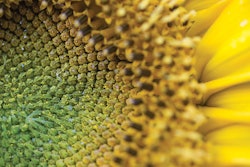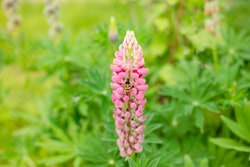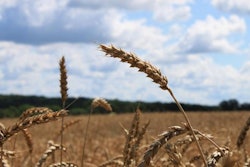
Although alfalfa is considered a roughage for ruminants, there are specific cases where dehydrated alfalfa meal can or should be used in diets for monogastric animals.
Alfalfa (Medicago sativa), also called lucerne, should not be confused with clover (Trifolium L.) also known as trefoil, even though they all look very similar. Alfalfa is a major forage crop of superior nutritive value reserved for the most productive and sensitive ruminant animals. Nevertheless, alfalfa, once dried, ground and often pelleted, can be used in feeds for certain monogastric animals with success and here we shall examine the most important cases.
Before that, however, it is important to note that dehydrated alfalfa contains on average 90% dry matter, 17% crude protein, 25% crude fiber, 10% ash, 2% calcium, and it is rather poor in phosphorus with only 0.25%. Due to its high fiber concentration, it is not a rich source of energy, but energy is not the reason when alfalfa is used in diets for monogastric animals.
-
Layers
Good quality and freshly dehydrated alfalfa contains up to 500 mg/kg xanthophylls, an important yellow-orange pigment that can be used as a source of pigmentation for eggs produced with natural pigments. Assuming a layer feed requires about 25 mg/kg xanthophylls for sufficient egg-yolk pigmentation, adding 5% alfalfa meal in such feed can eliminate the need for non-natural pigment supplementation. Corn also contains about 25 mg/kg xanthophylls, but other cereals contains negligible levels of pigments. Of course, other more reddish natural pigments may be needed to impart a more golden hue to eggs as desired by some markets, and the issue of natural pigment stability should also be considered.
-
Broilers
When broiler growth needs to be slowed down, for whatever reason, alfalfa is an excellent choice as it can provide enough fiber without making feed unpalatable. It is also readily available on the market and, as such, it can be incorporated quickly in any formula throughout the year. In fact, old broiler (and layer) formulas always included 2.5-5% alfalfa meal to impart a good color on broiler skin (and eggs) and also to help the digestive system. This practice has been abandoned now to allow for space for more energy-dense feed ingredients required in high-energy modern broiler feeds.
-
Rabbits
In rabbit feeds, an average of 50% dehydrated alfalfa meal is routinely used, at least in high-quality products. Otherwise, this level drops to 25% (or even lower) while the remaining is covered by wheat straw and other inexpensive sources of protein and fiber. Feeding alfalfa hay is also recommended for rabbits, but that is often a practice followed on small farms only. Nevertheless, alfalfa has an excellent fiber profile that is difficult to replicate using other sources of fiber in rabbit diets.
-
Gestating sows
Although a bit more expensive than other fiber sources, dehydrated alfalfa meal of lower quality is an excellent and appetizing source of fiber that satisfies hunger in limit-fed gestating sows. In their case, feeds must be pelleted or cubed when alfalfa is used. The extra time required to chew the alfalfa-containing pellets or cubes also satisfies the sow’s need for foraging and feed-related activities. The exact amount of alfalfa to be used depends on cost considerations and the maximum level of fiber required in the final feed.
-
Horses
Horses are also another monogastric species where alfalfa is used, albeit in restricted quantities to avoid digestive problems. Otherwise, it is an appetizing alternative to straw that is readily consumed, especially by working horses that require extra protein. In their case, alfalfa hay or pellets can be used interchangeably, depending on the feeding system and preferences of the stable.
Dehydrated alfalfa meal or pellets is an expensive ingredient, but its cost is justified by its superior nutritive, palatability and excellent fiber profile. The only concern required when buying dehydrated alfalfa products is to ensure they are of the best possible quality when such value is required because inappropriate drying processes can easily destroy all good characteristics of alfalfa.

















